2. Note that all rubber boot brackets, retaining rings, and mounting brackets must be replaced whenever removal and installation procedures are performed.
3. Clean the shaft before disassembling, clamp it in a vice.
External CV joint - removal and reassembly
4. Remove the brackets of the protective cover, pull the cover from the connection to the middle of the wool.
5. Remove the mounting bracket, remove the external connection from the shaft assembly. Remove the cover, and finally the retention bracket.
6. When installing, wrap insulating tape around the end of the wadding to protect the rubber boots from damage. Install a new small bracket, put the covers on the drive shaft. Remove the tape, install a new mounting bracket in the groove at the end of the wadding.
7. Install the outer CV joint on the wat. If an old CV joint is used, align the marks made before removal. Install the drive shaft nut.
8. Fill the connection with the correct amount of the specified type of lubricant (provided with repair kit), twist the connection and check that everything inside is filled with lubricant, squeeze the rest inside the rubber boot
9. Pull the covers over the outer joint, install the new large bracket and clamp it as shown in Fig. 8.7, then bend the end and secure it under the clamp tabs as shown in Fig. 8.8.
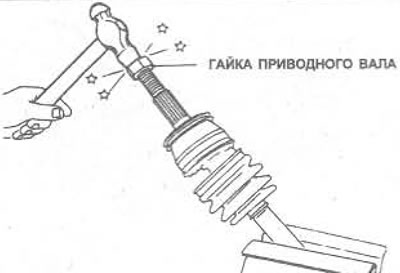
Pic. 8.6. Installing an outer CV joint on the drive shaft
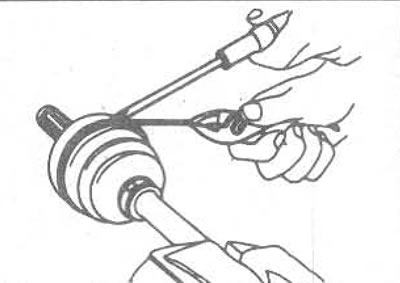
Pic. 8.7. Compressing the drive shaft boot bracket
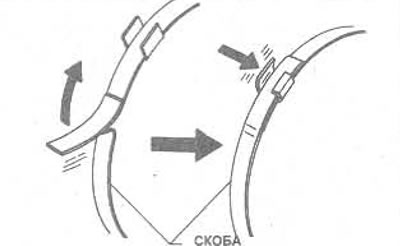
Pic. 8.8. Secure the ends of the bracket with clamps
10. Install the covers so that their length is as shown in fig. 8.9, remove all air from inside. Check that the smaller horse is seated in the groove of the drive shaft and check that the boots are not stretched or deformed. Install the smaller bracket on the covers, clamp it as shown in fig. 8.7, then bend the end and secure it under the clamp tabs as shown in Fig. 8.8.
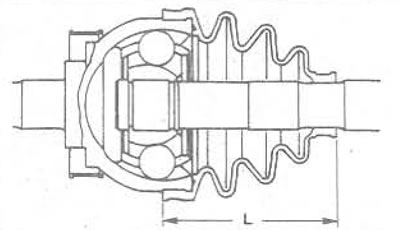
Pic. 8.9. Installation length of external connection cover: L = 96.0 - 98.0 mm
External CV joint - check
11. The external connection cannot be repaired and if it is worn or damaged, it must be completely replaced.
12. Clean the compound in solvent, dry it (compressed air).
13. Check each ball for corrosion or wear, internal and external grooves of the balls.
14. Check the outer end of the connection. The threads and alignment along the entire length must be in good condition.
15. If the connection is worn or damaged, it must be replaced.
16. Note that on later models a shield is installed over the joint to protect the wheel bearing from dirt or water.
17. Inspect the rubber connection boot carefully for cracks, splits, or other wear or damage. If necessary, replace the cover.
Inner CV joint - removal and reassembly
18. Remove the boot brackets, pull the boot from the connection to the middle of the shaft.
19. Mark the position of the connection body on the cotton wool, remove the connection body from the spider. Mark the position of the spider on the cotton wool, remove the retaining ring from the end of the cotton wool. Remove the spider and the cover from the cotton wool (Pic. 8.10).
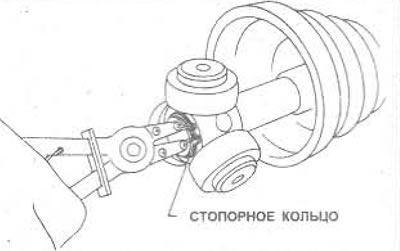
Pic. 8.10. Remove the retaining ring
20. Installation is carried out in reverse order.
21. Apply lubricant around the spider rollers and into the joint housing. Place the connection body on the spider.
22. Pull the housings onto the connection body, remove all air, install a new large bracket and clamp it as shown in Fig. 8.7, then bend the end and secure it under the clamp tabs, as shown in Fig. 8.8.
23. Install the covers so that their length is as shown in fig. 8.11. Check that the smaller end is seated in the groove of the drive shaft and check that the boots are not stretched or deformed. Install the smaller bracket on the covers, clamp it as shown in fig. 8.7, then bend the end and secure it under the clamp tabs as shown in Fig. 8.8.
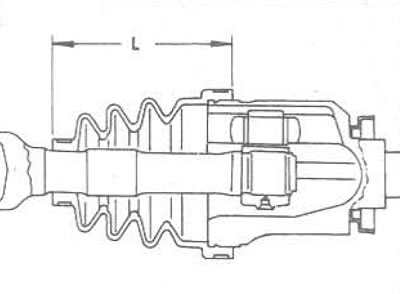
Pic. 8.11. Installation length of internal connection cover: L = 101.5- 103.5 mm
Inner CV joint - check
24. Clean the parts completely using a suitable solvent so that no traces of lubricant remain, then dry them with compressed air.
25. Check the condition of the CV joint assembly. If there is damage or wear, the spider must be replaced.
26. Check the condition of the CV joint housing, especially the spider rollers. Replace the housing if it is worn or damaged.
27. Check the rubber boots carefully. Replace them if in doubt about their condition.
Drive shaft - check
28. If both CV joints were removed as described above, you can check the condition of the drive shaft. Replace the drive shaft if necessary.
29. If the drive shaft needs to be replaced, note that they are only available as part of a complete assembly or as part of a drive shaft repair kit.
Support bearing - removal and reassembly
30. On 1.8 and 2.0 liter models, remove the bearing retaining ring using pliers.
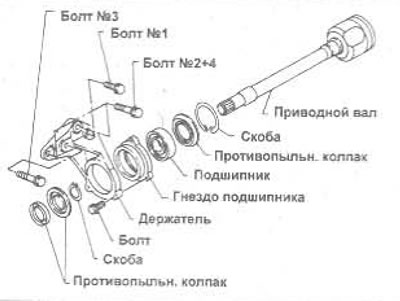
Pic. 8.12. Carrier Bearing Assembly - 1.8 and 2.0 Liter Models Only
31. Press the bearing housing and bearing out of the internal joint of the flared shaft as shown in Fig. 8.13.
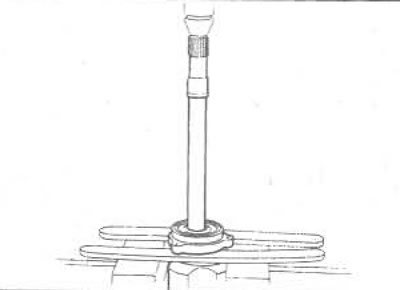
Pic. 8.13. Installing the holder bearing on the inner CV joint shaft
32. Turn the assembly over, remove the large retaining ring using pliers, then remove the dust shield.
33. When assembling, apply lubricant to the housing, install the dust shield and a new large snap ring (Pic. 8.14). Make sure that the inner race of the bearing is fully supported. Press the flared part of the internal joint shaft into the bearing until the smaller snap ring fits into the groove.
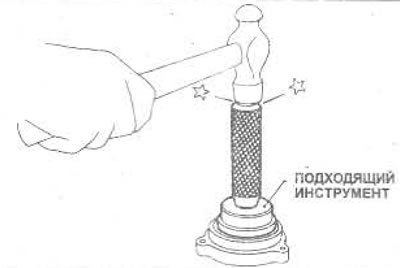
Pic. 8.14. Driving the carrier bearing into the housing - the tool should only be attached to the outer race of the bearing
34. Install two dust shields on the bearing housing and the inner end of the drive shaft, respectively.
Support bearing - check
35. None of the components of the support bearing assembly can be repaired (except bearing hanger and bolts). If there is wear or damage, they need to be replaced. Nissan recommends that the bearing snap rings be replaced each time they are removed.
36. To check the bearing, clamp the inner ring and quickly rotate the outer ring, check if there is any play between them. The bearing should rotate smoothly and smoothly, and there should be no play between the inner and outer rings.
37. Check all other components of the bearing assembly and replace them if necessary.